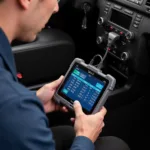Learning how to use a Suzuki scan tool for TPMS reset is an essential skill for any Suzuki owner or mechanic. This guide provides a step-by-step process, explaining the nuances of TPMS systems and how to effectively utilize a scan tool for resetting them. We’ll cover various aspects, from understanding the different types of Suzuki scan tools available to troubleshooting common issues you might encounter.
Understanding the Suzuki TPMS System
The Tire Pressure Monitoring System (TPMS) is a crucial safety feature in modern Suzuki vehicles. It constantly monitors tire pressure and alerts the driver if any tire is significantly under-inflated. This helps prevent accidents caused by tire failure, improves fuel efficiency, and extends tire lifespan. There are two main types of TPMS: direct and indirect. Direct TPMS uses sensors within each tire, while indirect TPMS relies on the vehicle’s ABS system to estimate tire pressure. Suzuki predominantly utilizes direct TPMS.
Choosing the Right Suzuki Scan Tool for TPMS Reset
Selecting the appropriate scan tool is crucial for a successful TPMS reset. There’s a wide range of options available, from basic code readers to professional-grade diagnostic tools. While a simple code reader might be sufficient to read TPMS codes, a more advanced scan tool is typically required to perform a TPMS reset, especially for newer Suzuki models. Factors to consider include compatibility with your specific Suzuki model, the tool’s functionality, and your budget.
 Suzuki Scan Tool Options for TPMS Reset
Suzuki Scan Tool Options for TPMS Reset
Step-by-Step Guide: Using a Suzuki Scan Tool to Reset TPMS
Before beginning the reset process, ensure your tires are inflated to the recommended pressure listed on the sticker located on the driver’s side doorjamb. Here’s a general guide using a typical Suzuki compatible scan tool:
- Connect the scan tool: Plug the scan tool into the OBD-II port, usually located under the dashboard on the driver’s side.
- Turn the ignition on: Turn the key to the “on” position without starting the engine.
- Select TPMS: Navigate to the TPMS section within the scan tool’s menu.
- Choose “Reset” or “Relearn”: The wording may vary depending on the specific scan tool.
- Follow on-screen instructions: The scan tool will guide you through the remaining steps, which may involve driving the vehicle at a specific speed or using a TPMS activation tool.
Troubleshooting Common TPMS Reset Issues
Sometimes, the TPMS reset process might not go smoothly. Here are some common issues and solutions:
- Scan tool not communicating: Check the connection to the OBD-II port and ensure the ignition is on.
- Incorrect tire pressure: Verify that all tires are inflated to the correct pressure.
- Dead TPMS sensor: A faulty sensor may need replacing. Consult a professional if you suspect this.
Why Professional TPMS Reset is Sometimes Necessary
While DIY TPMS resets are often possible, certain situations require professional assistance. For instance, if you’ve replaced a TPMS sensor, a professional will need to program the new sensor to the vehicle. Additionally, more complex TPMS issues may require specialized diagnostic equipment and expertise.
Conclusion
Using a Suzuki scan tool to reset your TPMS can be a straightforward process. Understanding the system and following the correct steps will ensure your TPMS functions correctly, enhancing safety and vehicle performance. Remember to consult your vehicle’s owner’s manual or a qualified technician if you encounter any difficulties.
FAQ
- How often should I reset my TPMS? Generally, a TPMS reset is only necessary after rotating tires, replacing a sensor, or adjusting tire pressure.
- Can I use any OBD-II scanner to reset my Suzuki TPMS? No, you’ll need a scan tool specifically compatible with Suzuki TPMS systems.
- What happens if I ignore a low tire pressure warning? Ignoring low tire pressure can lead to tire failure, reduced fuel efficiency, and compromised handling.
- How long does a TPMS reset take? The process usually takes a few minutes to complete.
- What is the cost of replacing a TPMS sensor? The cost varies depending on the make and model of your Suzuki.
- How do I know if my TPMS sensor is bad? Signs of a bad sensor include a constantly illuminated TPMS light, inaccurate tire pressure readings, or no readings at all.
- Can I drive with a bad TPMS sensor? While you can drive with a bad sensor, it’s not recommended. You won’t receive accurate tire pressure readings, which could compromise safety.
Common TPMS Reset Scenarios
- After rotating tires: This is a common scenario where a TPMS reset is required to ensure the system correctly identifies the location of each tire.
- After replacing a tire: If a tire is replaced, the corresponding TPMS sensor may also need to be replaced and programmed.
- After adjusting tire pressure: While a reset isn’t always necessary after adjusting tire pressure, it can be helpful to ensure accurate readings.
Related Articles & Questions
- How to Choose the Right TPMS Sensor for your Suzuki
- Understanding Suzuki Diagnostic Trouble Codes
- Common Suzuki TPMS Problems and Solutions
Need assistance? Contact us via WhatsApp: +1(641)206-8880, Email: [email protected] or visit us at 276 Reock St, City of Orange, NJ 07050, United States. Our customer service team is available 24/7.


